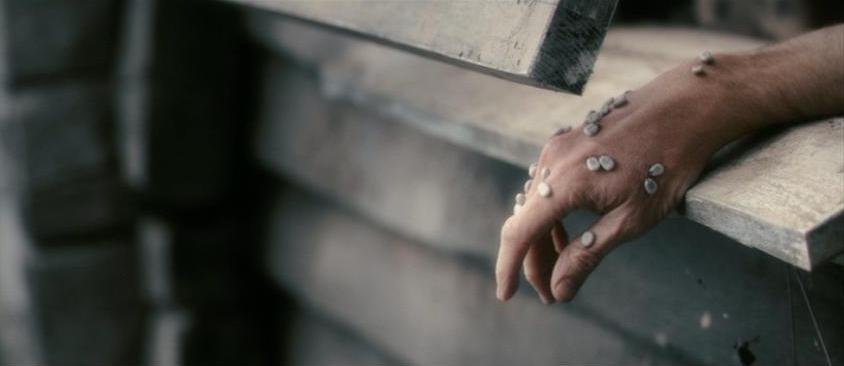
Lars von Trier's Antichrist is a highly debated film. I do not think that any director would squander a film, based on a ridiculous fiction and infrastructure, which he spends millions of dollars, effort, time and thoughts on. Especially if the director is Lars von Trier, the situation is getting utterly different and he does not have any difficulty in provoking the audience who is not accustomed to the structure. When we look at the filmography of Trier, we do not have any difficulty in noticing the special interest that he shows to the elements of consciousness.
Especially when it comes to behaviors which are considered exaggerated, abnormal, and extraordinary, Trier is not a novice at all. He reconciles symbols and metaphors which are outside of his era with a consciousness that is considered ill. He easily reflects the emotions and thoughts that he feels, on the screen, as someone who personally has the perspective of this privileged depression state. And more, he doesn't hold himself back to use this state as a therapy session and thus Trier makes a multi-layered film that turns into a Rorschach test, in which the layers are interleaved independently of each other. Throughout the film, the distinction between reality and fantasy cannot be made and it does not give us the opportunity to create a built-in sense of reality. For this reason, it is meaningless but fun to try to interpret the film seriously, without training in aesthetics and philosophy or by training.
If we are to express what we mean by Christ etymologically in Greek, it means ''covered with oil'' or ''cleansed with sacred oil'' ''blessed''. In Hebrew it means ''clean'' ''which has moral values''. Antichrist will give the opposite of these meanings, that is, ''unblessed'', ''dirty'' or ''which has no moral values'' and also the bedside book of Trier since the age of 12 which is written by F. Nietzsche.
The woman is characterized by atypical depression (highly affected by life events, highly sensitive to neglect and rejection, increased sexual activity) and psychosis consistent with schizophrenia (hallucinations, delusions, affective adjustment, carelessness in assessment, aggressive-agitation, strange sexual behavior).
If we are going to approach the film chronologically: the woman has abandonment delusions. We find that the child, Nic, was being forced to wear his shoes on the wrong feet by his mother so that he cannot go far away and abandon her. She is working on a thesis which has a dissertation topic on gynocide that we do not know whether it is accredited academically or not. Nature and the human nature that causes bad things to happen to women throughout history is the subject of the thesis. When the man opens the book and examines it, we see that the woman's writing is getting worse and irregular, and the woman becomes incapable where she cannot read her own writing, which should make us suspect of psychosis. The woman expresses that she has stopped writing when fears and anxieties got more and more. When we also pay attention to readable pages we also see that mentions of traditionally institutionalized witches (clergy) and modern witches (psychotherapists).
''In The Gay Science, Nietzsche suggests that Socrates considers his hemlock poison as a cure for life when he drinks it, and that Socrates has suffered from this disease for a long time.''
The woman's sexual activities are so much that she cannot / does not intervene when Nic, her son, throws 3 beggars symbols (grief, pain and despair) down from the table with his hand and drops himself out of the window. We understand that she has spent a month in the clinic after his son's death and the husband who is not a medical doctor but a psychotherapist thinks that his wife is not suitable for the medical treatment and he is undertaking her treatment in a Freudian way. She quits her drugs and we are witnessing that the mood that has been stabilized is slowly deteriorating. We witness that the woman hurts herself and her husband before going to the forest house. The man here refuses the methods of modern psychiatry by behaving impulsively and arrogantly.
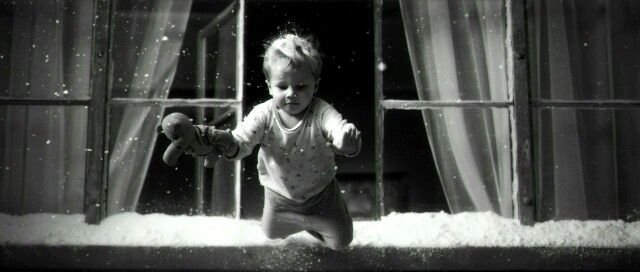
Psychotherapy and inferences have been heatedly debated until this day. Popper, Chomsky, Pinker, Gould, Feynman, Grünbaum, Foucault and Deleuze are critical of the approach to psychotherapy as a science. E. Fuller Torrey notes that psychoanalytic methods are no more scientific than methods of contemporary witches.
''Two people know each other, but already knew each other, and do not yet know each other. Betrayal happens, it never happened, and yet has happened and will happen, sometimes one betraying the other and sometimes the other betraying the first—all at the same time. (Deleuze, 98)''
In the film, there is a nice detail about the blue flowers, when the man enters the room in the clinic we see the blue flowers in his hands. The concepts that the blue flowers usually symbolizes are the beauty of things, hope, desire, love, eternity and unattainable. The camera focuses on these flowers for 15-20 seconds, and we see that the flowers dissolve and settle in a sense of decay. Blue flowers are also a symbol that David Lynch often uses.
When the man and woman try to cure the mourning instead of accepting the mourning, events start to derail. The man attempts to apply Freudian rhetoric: he tries to treat the obsessions, but instead finds himself intensifying the obsessions. For example: trying to overcome nightmares' anxieties by reviving the nightmares. When she travels to Eden during hypnosis, she stands on a bridge, which symbolically can be interpreted as a passage between conscious and the subconscious. We begin to watch the violence that the psychotherapist (or clergyman/witch hunter), who is on the journey within social subconscious of women which is built and divided in half by Christian myths, will be exposed to (such as ticks stick to the man's hand) by individual and social subconscious of women imprisoned in Christianity/Catholicism/Protestantism and harmed throughout history by various means and methods. Arrogance, absoluteness, and certainty are not welcomed in women's subconscious.
The woman expresses that the ground is burning, but in reality, we see that her soles are peeled, that is, she cannot properly establish the cause-effect relationship. Symbolically we see a reindeer (totem) which is giving birth to a stillborn and a bird that falls from its nest as bait to other birds or their parents (ants, eagles) in nature. Another symbol of nature's productivity, desire for prolonged breeding and the continuation of its descendants, is that the oak trees are seeded extensively and that only a few of them continue their descent throughout the centuries. Tarkovsky's The Sacrifice is referred here in a formal and contextual sense.
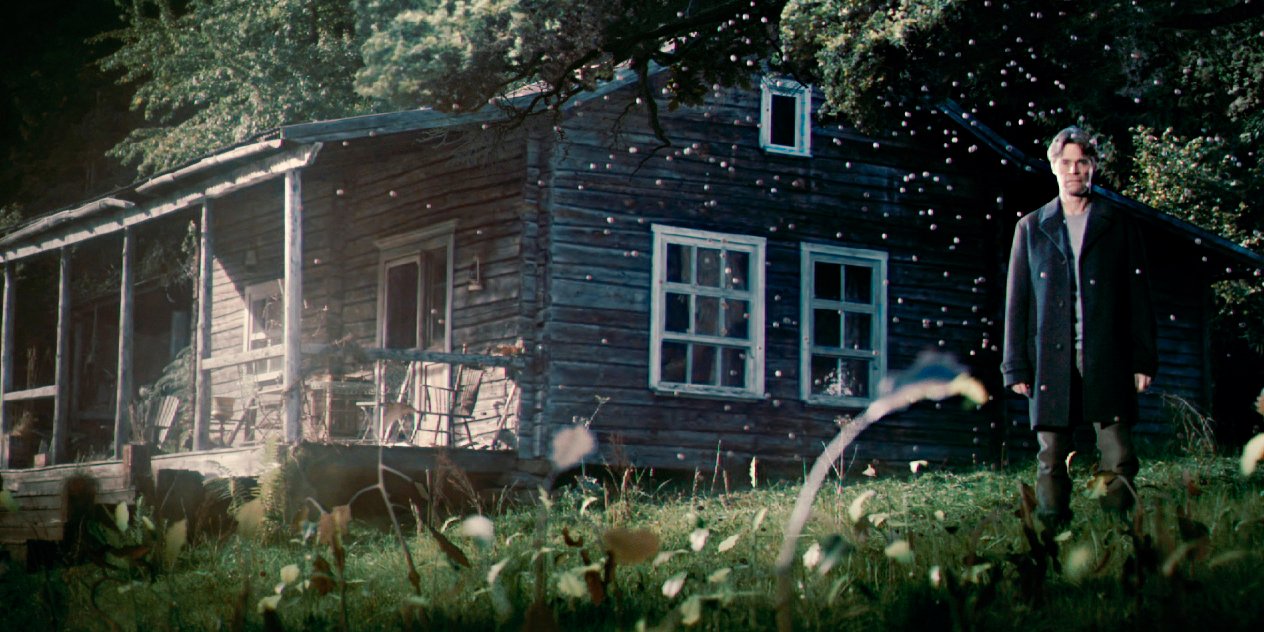
''Freud is dead, isn't he?''
She says she heard the voices of dying things coming from the forest when she talks with the man and when she controls her child we see that Nic is joyfully playing. That is, we understand at the same time she has hallucinations as delusions. When the man rationalizes the situation and explains it, she attacks the man. Christianity, which is prescribed for the protection from nature, unrest and the tragedies created by uncertainty, is strongly unwelcomed by the individual. At the end of Film the woman speaks of supernatural powers, saying that nature is the devil's church and that when the window opens with the wind, the devil's brother comes. With such a belief in supernatural powers, she finds herself in a manic attack and begins to harm the man. We understand that the mind has been disintegrated with religious delusions, hallucinations, paranoia, and increased mystic affairs. An irony is made with a beautiful reference to Freud.
Considering Nietzsche's Antichrist book, and with the motive of destroying the most sacred, it is possible to keep the fox with cunning and logic. In addition, Trier plays a small game symbolizing the mind's entering a chaotic state, by the fox (mind) is eating itself and its intestines (maybe a reference to Ecce Homo), the mind's logic mood and the cause-and-effect relationship are disappearing. When the fox talked about the chaos it made me think that the man was in folie a deux independent from reality, but when we take Nietzsche into account, the myth seems to remind us that Dionysus emerged as symbolizing a new life in the form of a fox, and the three beggars probably symbolize totem-animals. Totems are sacred icons that serve as intermediaries between metaphysics and the physical world in primitive communities. Today, this task is seen in Christianity as a trinity of the Father, the Son, and the Holy Spirit. After the birth of Jesus Christ in Christian mythology, three kings / three wise men visit and give gifts to him; the three animals in the film (3 beggars) are probably the antagonists of these totems (Trinity) or three kings, and symbolizers of the antichrist world/nature. The film is not bad at all to explain how far any collective faith (religions, mystic affairs, etc.) could go, leading to social epidemic hysteria, in terms of causing thoughts and events such as the killing and burning of people who are thought to be related with mystic affairs. Today, we can see this social epidemic hysteria from social life, politics, and sects. We adapt to situations that need to be surprised and to be challenged, we lose our will and become part of these events if we do not hold our will and our conscience higher than the consciousness and the will of the madness.
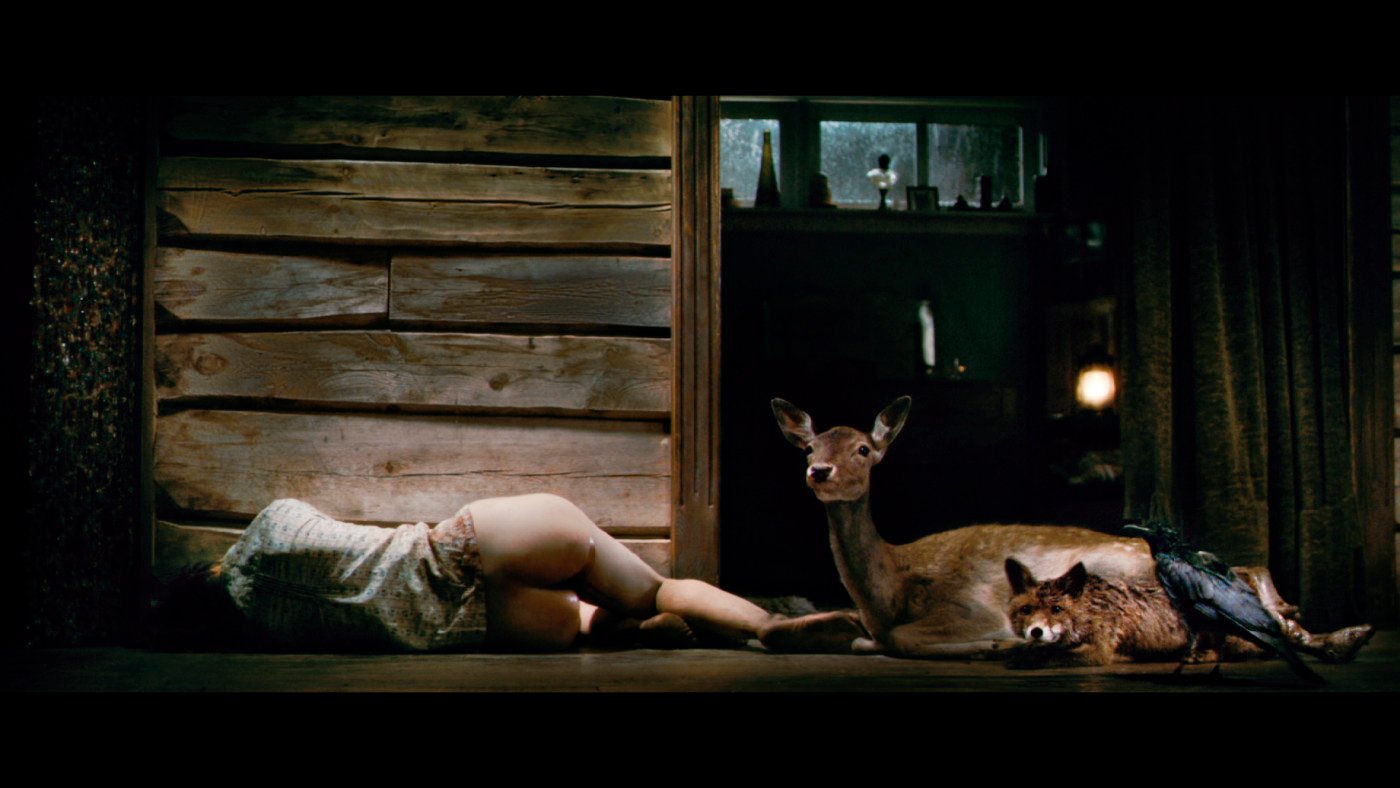
Nietzsche argues that the tension between Apollonian and Dionysian aesthetic principles contributed to the development of the Greek tragedy; Dionysus represents uncontrolled, chaotic, and irrational, whereas Apollo represents rational and orderly. Dionysus is a character who is the guardian of the non-members of the traditional society and also symbolizes the chaotic, dangerous, unexpected, and incompatible actions of the gods which are unpredictably attributed. Dionysus's wine, music, and dance frees his followers from fear and anxiety; also referred to as Eleutherios, which means liberating and destroying the oppressive constraints of the strong. The female followers of the Dionysus are called Maenads which means "raving ones". Maenads are present in the blood presentation to feed the dead; Dionysus plays an intermediary role between those who live in this soul cult and the dead. His another name is "running in the forest".
''I discovered something else in my material than I expected. If human nature is evil. Then that goes as well for the nature of … of women … female nature. The nature of all the sisters. Women do not control their own bodies. Nature does …''
Here we see the association of nature with feminine gender and the association of violence against women in society. The woman who is referred to have caused the most basic sin of man, being fired from heaven, and of course, when the man hears these cues, we are witnessing his objections to the woman. This first sin was one of the cornerstones of the inquisition courts and Malleus Maleficarum. ''You don't have to understand me, just trust me.'' We are watching the man once again brings his arrogance to the foreground with the answer given here.
In Malleus Maleficarum (the manual handbook used in the trial of the witches in the 15th century, basis of medieval inquisition courts) women were more likely to be related with witchcraft because feminine gender was argued to have a greater variety of weaknesses against evil temptation and is accused of killing babies, eating flesh and destroying the penis, and women who did not cry during the trial were considered witches. In this case, a reference is made in the film with "the crying woman is a scheming woman" and the book mentions that women are using their own bodies to deceive. Of course, it is an unquestionable fact that all of these are nonsense today, so there is no need for a feminist point of view. When we look at the filmography of Trier, we see that Trier brings serious criticism of patriarchy in Breaking the Waves, Dancer in the Dark, Dogville, and he explodes in reaction to the women who are subjugated. In Antichrist, we see that the explosion level raises by challenging the audience intellectually.
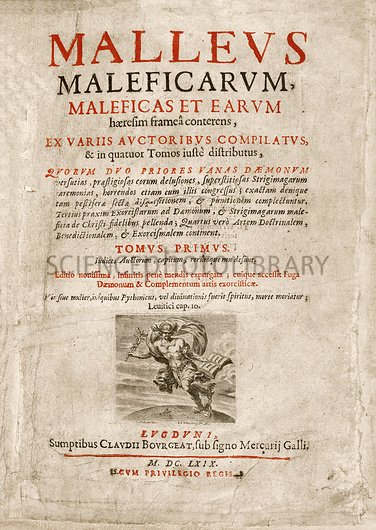
''The sisters from Ratisbon could start a hailstorm''
In medieval Germany, two women named Agnes and Anne are accused of witchcraft by being held responsible for a full storm that damages fruit and grapes near around Ratisbon (Regensburg), and they are subject to trial because of their involvement with the demon and strengthening its affairs. They are burned to death as a result of the trial. In Malleus Maleficarum, it is mentioned that witches can create floods full of lightning. In Malleus Maleficarum, such weather events are important, and the book also mentions the Antichrist as a devil. The woman starts to masturbate under the tree, and while she is having sex with the man identified as the devil, the sadomasochist mood comes to the fore and she thinks she should suffer because of her mistakes. We see the female bodies that emerge from the roots of the tree in the background. This again reminds me of the cult: a woman and orgy as promised, just as if the feasts of the god of immorality and madness, Dionysus. I think those who are trapped in the roots of the tree are those who have given themselves up to sin and arrogance, and the sex scene under the tree foresees the collapse of the characters.
''I consider life itself instinct for growth, for durability, for accumulation of forces, for power: where the will to power is lacking there is decline. (Antichrist, F. Nietzsche)"
"... this entire fictional world has its roots in hatred of the natural (—actuality!—). (Antichrist, F. Nietzsche)''
The man looks at Nic's photos and finds out that the shoes are on the wrong feet in all photos and he confronts the woman with this incident. Violence starts to climb. The woman reveals her delusions again by saying "Will you leave me?" and trying to make love with the man because of the anxiety of being rejected by entering a manic attack, and she starts to masturbate to the man's penis just after hammering it and then puts a weight on the man's leg to lighten her abandonment delusion. There is likely to be borderline on axis II. Extravagant love turns into extravagant hate. The man escapes and ironically hides in the fox's nest. Here we encounter the third totem, the crow, which is a symbol of despair trying to survive perseveringly. We see the forest is foggy and the woman buries the man in the nest. Chapter 4 starts and we see that the night falls, the woman gets out of the manic drive and takes him out of his buried place. Just after that, the woman cannot find the tool when she tries to remove the stone from his leg. However, the woman had thrown the tool under the house so that we notice the woman has amnestic disorder. Also when the man shows the child's photos to the woman, the woman says she cannot remember.
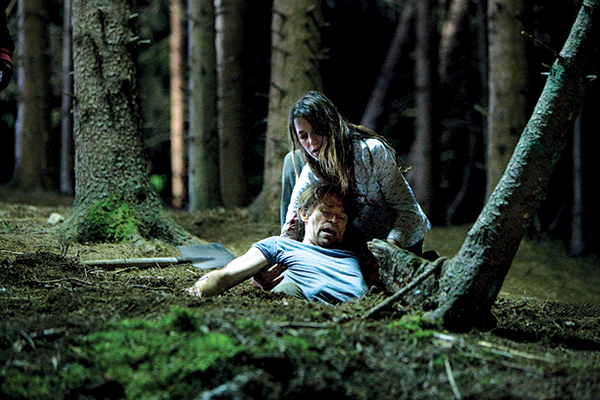
Despite the psychiatrist who tells that she has atypical depression at the beginning of the film, the psychotherapist is still rejecting the situation with arrogance. Self-fulfilling prophecies (eg. when the three beggars come one of us will die) take place which in turn leads us to think about schizophrenia, there is actually no constellation of three beggars but the man is late to realize the situation (Meanwhile, there is a constellation known as the three kings also usually known as Orion's Belt). The woman remembers Nic's fall and punishes herself by self-circumcision in purpose of relieving anxiety caused by guilt feelings. She is trying to make themselves innocent again in Eden Garden by reversing the original sin by mutilating their own genitals. The woman is shouting and it starts to hail. At this time the totem-animals are coming in. In the screaming scene, the image gets gothic and the man probably imagines the woman as a witch. The man is taking the stone out of his leg and the image gets gothic again. Today's psychotherapist kills his wife, whom he considers as a patient, when there is no reason to kill her. Then he turns into a witch hunter by burning his wife.
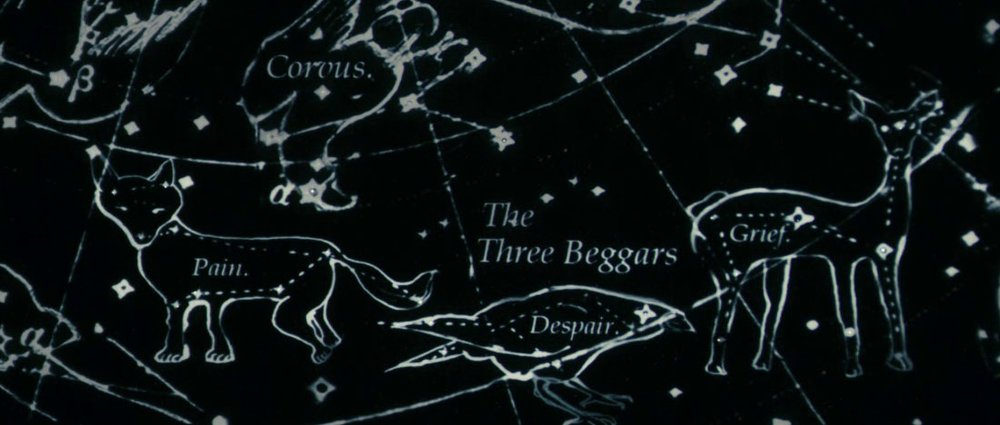
''...], but the wild wild-boars of the forest, by which is meant any form of heathendom and heresy, has eaten and plundered it, has ruined the beautiful fruits of faith and has planted wild thorn berries among the vines and the intriguing worm, the evil enemy of our human race, who is Satan and the devil, has breathed his poison and empoisoned the fruit of the vineyard with the heretical plague. (Kramer, Malleus Maleficarum, 156)''
In the epilogue, we watch the man as he limping out of Eden Garden, and as the man is eating the berries desirously. The Father, the Son, and the Holy Spirit totems (or three beggars, which are the opposite of the three kings) emerge next to the man, and women without faces (Maenads or witches throughout history) are liberated by going on a journey towards to the top of the Eden hill. This journey reminds me of portraits of Hell, Purgatory and Paradise in Dante's Divine Comedy. In Dante's comedy, there is also Purgatory, unlike the classical Christianity before 12th century, which consists of seven levels and on the seventh floor is Eden Garden which is on the top of the mountain. The holy forest here is the opposite of the "dark forest" at the beginning of hell. The garden, which Adam and Eve lived before eating the forbidden fruit, symbolizes the souls who purify their sins by climbing the mountain of Purgatory.
''... the focus point of criticism is the culture that encodes the weak and the strong as innocent and criminal, and the culture makes the strong stronger and the weak weaker. It is conscious of vengefulness that this cult is based upon. The criticism that women and men should take account is that they must be sure of the innocence of their consciousness, the consciousness of interpreting the world to be arrogant at all costs. (Yasin Yildirim)''
''There are two types of dreams: in one of them, the dreamer controls the action: he controls what happens and what will happen: he is a demiurge. In the other, he is incapable of getting control and becomes the victim of violence, against which he cannot defend himself. It all results in pain and anxiety. (The Sacrifice, disc 2)''
''Two years ago, I suffered from depression... Six months later, just as an exercise, I wrote a script. It was a kind of therapy, but also a search... To see if i would ever make another film. The script was finished and filmed without much enthusiasm... The work on the script did not follow my usual modus operandi. Scenes were added for no reason. Images were composed free of logic or dramatic thinking. They often came from dreams I was having at the time, or dreams I’d had earlier in my life. Once again, the subject was “nature” but in a different and more direct way than before... The film does not contain any specific moral code and only has what some might call ‘the bare necessities’ in the way of a plot... In any case, I can offer no excuse for “Antichrist”. Other than my absolute belief in the film… (Lars von Trier, Cannes)''
Sources and further reading:
introductory textbook of psychiatry 6th ed. edition | professor of psychiatry donald w black, andrew h woods chair of psychiatry nancy c andreasen m.d. ph.d.
antichrist, ecce homo, beyond good and evil, the gay science, the birth of tragedy | friedrich nietzsche
divine comedy | dante alighieri
antichrist—chaos reigns: the event of violence and the haptic image in lars von trier's film | bodil marie stavning thomsen
antichrist ne anlatıyor? – i | yasin yildirim
antichrist ne anlatıyor? – ii, nietzsche’nin antichrist’i | yasin yildirim
antichrist ne anlatıyor? – iii, trier’in zerdüşt’ü | yasin yildirim
lars von trier, "antichrist press kit" (2009 cannes film festival), cannes festival
http://www.rogerebert.com/…trier-and-the-antichrist
http://www.filmquarterly.org/…ichrist-a-discussion/

